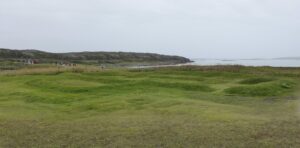
Towards the end of the summer I crossed the North Atlantic by sea. Island hopping. It was a magnificent journey. But it is a challenging route, even in modern times. It left me with a strong sense of respect for those who travelled this crossing in previous centuries.
The main voyagers for whom the route is famous are, of course, the Norse, and one comes across the footprint of their achievements at every step of the way. It is a thought-provoking sight to gaze across the familiar footings of a turf longhouse set on to a remote peninsula of North America. L’Anse aux Meadows, identified as the small settlement built by Leif Eriksson and his followers on their early trips to Vinland around 1000 AD, is not an easy place to reach even today. Cruise ships have to moor offshore and passengers must transfer to small tenders to step ashore. Local weather conditions can make this chancy. Others face a long journey north from the nearest settlements; the airport is a five-hour drive away. It has long been one of my ambitions to get here and was one I never thought I’d achieve. Not surprisingly I felt a frisson of emotion as I gazed out over the traces of the houses built by Leif and his family and companions. We had been caught by bad weather in the preceding days and it was by no means certain that we’d be able to land.
Even on my state-of the-art ‘Viking Ship’ we were, therefore, only too aware of high winds and rough seas as we progressed eastwards from Norway. Yet, those who travelled from island to island across this ocean a thousand years ago, in vessels that were largely open, were rarely content with a single journey. Many made the crossing time and again. They relied on very different skills. An ability to read the waves and the currents, an understanding of wind, the interpretation of ancient stories, knowledge of distant shores, the lore of the stars, and, when need demanded, brute strength to pull oar, or control sail and rudder. This was their technology. Of course, many did not survive, and I am sure that those who set out never under-estimated the undertaking. These were journeys from which one might not return.
The apparent ease with which twenty-first century technology can overcome distance and weather provides us with a sense of security that our ancestors can never have known. Amazingly, we set out on these journeys for recreation. Somehow, wherever we are going, I feel that it is important not to lose sight of their achievements when we do so. It was the aspiration of past generations, after all, that peopled many of these lands and provided the foundations on which we rely today.
You must be logged in to post a comment.